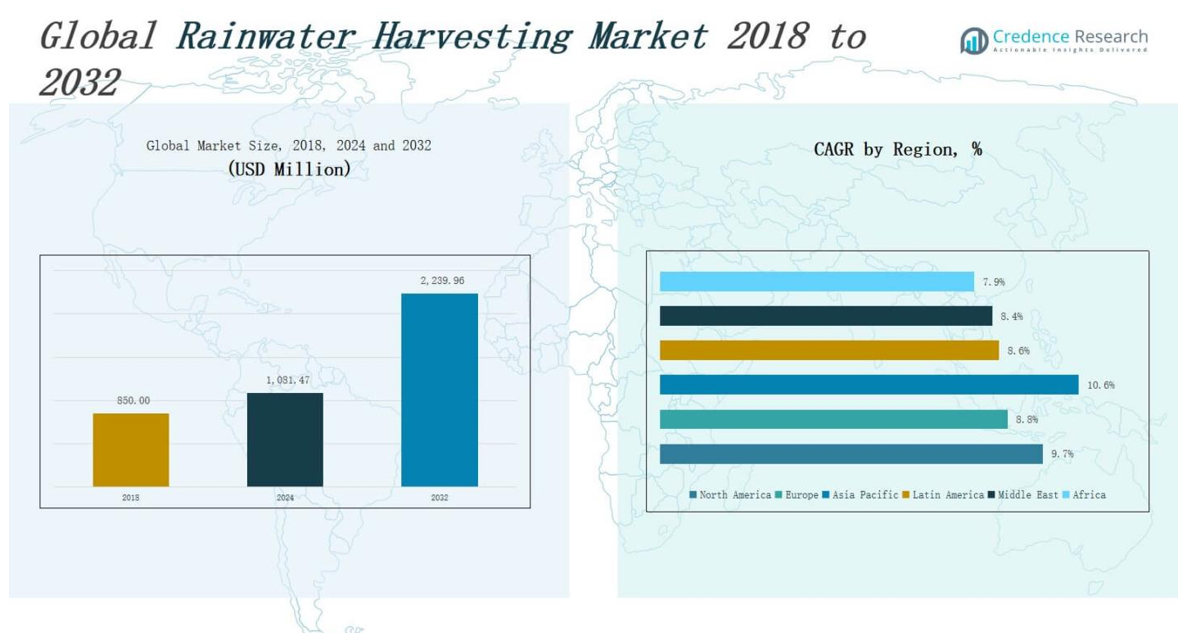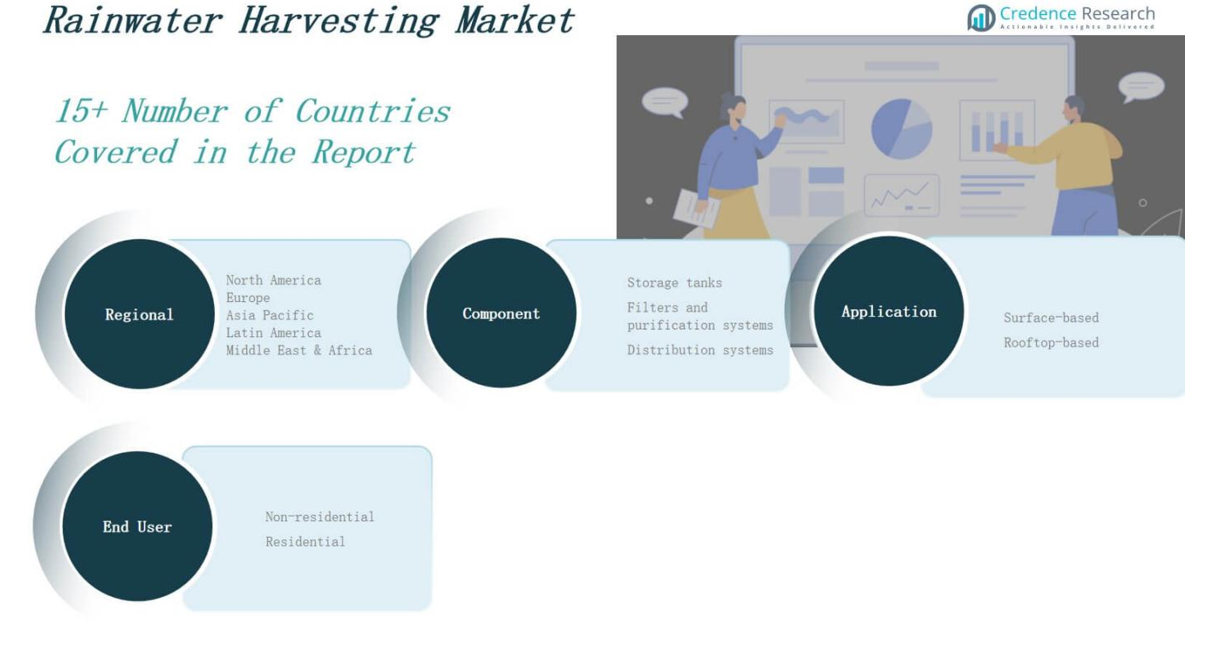CHAPTER NO. 1 : GENESIS OF THE MARKET
1.1 Market Prelude – Introduction & Scope
1.2 The Big Picture – Objectives & Vision
1.3 Strategic Edge – Unique Value Proposition
1.4 Stakeholder Compass – Key Beneficiaries
CHAPTER NO. 2 : EXECUTIVE LENS
2.1 Pulse of the Industry – Market Snapshot
2.2 Growth Arc – Revenue Projections (USD Million)
2.3. Premium Insights – Based on Primary Interviews
CHAPTER NO. 3 : RAINWATER HARVESTING MARKET FORCES & INDUSTRY PULSE
3.1 Foundations of Change – Market Overview
3.2 Catalysts of Expansion – Key Market Drivers
3.2.1 Momentum Boosters – Growth Triggers
3.2.2 Innovation Fuel – Disruptive Technologies
3.3 Headwinds & Crosswinds – Market Restraints
3.3.1 Regulatory Tides – Compliance Challenges
3.3.2 Economic Frictions – Inflationary Pressures
3.4 Untapped Horizons – Growth Potential & Opportunities
3.5 Strategic Navigation – Industry Frameworks
3.5.1 Market Equilibrium – Porter’s Five Forces
3.5.2 Ecosystem Dynamics – Value Chain Analysis
3.5.3 Macro Forces – PESTEL Breakdown
3.6 Price Trend Analysis
3.6.1 Regional Price Trend
3.6.2 Price Trend by product
CHAPTER NO. 4 : KEY INVESTMENT EPICENTER
4.1 Regional Goldmines – High-Growth Geographies
4.2 Product Frontiers – Lucrative Product Categories
4.3 Application Sweet Spots – Emerging Demand Segments
CHAPTER NO. 5: REVENUE TRAJECTORY & WEALTH MAPPING
5.1 Momentum Metrics – Forecast & Growth Curves
5.2 Regional Revenue Footprint – Market Share Insights
5.3 Segmental Wealth Flow – Product Type & Application Revenue
CHAPTER NO. 6 : TRADE & COMMERCE ANALYSIS
6.1. Import Analysis by Region
6.1.1. Global Rainwater Harvesting Market Import Revenue By Region
6.2. Export Analysis by Region
6.2.1. Global Rainwater Harvesting Market Export Revenue By Region
CHAPTER NO. 7 : COMPETITION ANALYSIS
7.1. Company Market Share Analysis
7.1.1. Global Rainwater Harvesting Market: Company Market Share
7.2. Global Rainwater Harvesting Market Company Revenue Market Share
7.3. Strategic Developments
7.3.1. Acquisitions & Mergers
7.3.2. New Product Launch
7.3.3. Regional Expansion
7.4. Competitive Dashboard
7.5. Company Assessment Metrics, 2024
CHAPTER NO. 8 : RAINWATER HARVESTING MARKET – BY COMPONENT SEGMENT ANALYSIS
8.1. Rainwater Harvesting Market Overview by Component Segment
8.1.1. Rainwater Harvesting Market Revenue Share By Component
8.2. Storage Tanks
8.3. Filters and Purification Systems
8.4. Distribution Systems
CHAPTER NO. 9 : RAINWATER HARVESTING MARKET – BY APPLICATION SEGMENT ANALYSIS
9.1. Rainwater Harvesting Market Overview by Application Segment
9.1.1. Rainwater Harvesting Market Revenue Share By Application
9.2. Surface-based
9.3. Rooftop-based
CHAPTER NO. 10 : RAINWATER HARVESTING MARKET – BY END-USER SEGMENT ANALYSIS
10.1. Rainwater Harvesting Market Overview by End-user Segment
10.1.1. Rainwater Harvesting Market Revenue Share By End-user
10.2. Non-residential
10.3. Residential
CHAPTER NO. 11 : RAINWATER HARVESTING MARKET – REGIONAL ANALYSIS
11.1. Rainwater Harvesting Market Overview by Region Segment
11.1.1. Global Rainwater Harvesting Market Revenue Share By Region
11.1.3. Regions
11.1.4. Global Rainwater Harvesting Market Revenue By Region
.1.6. Component
11.1.7. Global Rainwater Harvesting Market Revenue By Component
11.1.9. Application
11.1.10. Global Rainwater Harvesting Market Revenue By Application
11.1.12. End-user
11.1.13. Global Rainwater Harvesting Market Revenue By End-user
CHAPTER NO. 12 : NORTH AMERICA RAINWATER HARVESTING MARKET – COUNTRY ANALYSIS
12.1. North America Rainwater Harvesting Market Overview by Country Segment
12.1.1. North America Rainwater Harvesting Market Revenue Share By Region
12.2. North America
12.2.1. North America Rainwater Harvesting Market Revenue By Country
12.2.2. Component
12.2.3. North America Rainwater Harvesting Market Revenue By Component
12.2.4. Application
12.2.5. North America Rainwater Harvesting Market Revenue By Application
2.2.6. End-user
12.2.7. North America Rainwater Harvesting Market Revenue By End-user
2.3. U.S.
12.4. Canada
12.5. Mexico
CHAPTER NO. 13 : EUROPE RAINWATER HARVESTING MARKET – COUNTRY ANALYSIS
13.1. Europe Rainwater Harvesting Market Overview by Country Segment
13.1.1. Europe Rainwater Harvesting Market Revenue Share By Region
13.2. Europe
13.2.1. Europe Rainwater Harvesting Market Revenue By Country
13.2.2. Component
13.2.3. Europe Rainwater Harvesting Market Revenue By Component
13.2.4. Application
13.2.5. Europe Rainwater Harvesting Market Revenue By Application
13.2.6. End-user
13.2.7. Europe Rainwater Harvesting Market Revenue By End-user
13.3. UK
13.4. France
13.5. Germany
13.6. Italy
13.7. Spain
13.8. Russia
13.9. Rest of Europe
CHAPTER NO. 14 : ASIA PACIFIC RAINWATER HARVESTING MARKET – COUNTRY ANALYSIS
14.1. Asia Pacific Rainwater Harvesting Market Overview by Country Segment
14.1.1. Asia Pacific Rainwater Harvesting Market Revenue Share By Region
14.2. Asia Pacific
14.2.1. Asia Pacific Rainwater Harvesting Market Revenue By Country
14.2.2. Component
14.2.3. Asia Pacific Rainwater Harvesting Market Revenue By Component
14.2.4. Application
14.2.5. Asia Pacific Rainwater Harvesting Market Revenue By Application
14.2.5. End-user
14.2.7. Asia Pacific Rainwater Harvesting Market Revenue By End-user
14.3. China
14.4. Japan
14.5. South Korea
14.6. India
14.7. Australia
14.8. Southeast Asia
14.9. Rest of Asia Pacific
CHAPTER NO. 15 : LATIN AMERICA RAINWATER HARVESTING MARKET – COUNTRY ANALYSIS
15.1. Latin America Rainwater Harvesting Market Overview by Country Segment
15.1.1. Latin America Rainwater Harvesting Market Revenue Share By Region
15.2. Latin America
15.2.1. Latin America Rainwater Harvesting Market Revenue By Country
15.2.2. Component
15.2.3. Latin America Rainwater Harvesting Market Revenue By Component
15.2.4. Application
15.2.5. Latin America Rainwater Harvesting Market Revenue By Application
15.2.6. End-user
15.2.7. Latin America Rainwater Harvesting Market Revenue By End-user
15.3. Brazil
15.4. Argentina
15.5. Rest of Latin America
CHAPTER NO. 16 : MIDDLE EAST RAINWATER HARVESTING MARKET – COUNTRY ANALYSIS
16.1. Middle East Rainwater Harvesting Market Overview by Country Segment
16.1.1. Middle East Rainwater Harvesting Market Revenue Share By Region
16.2. Middle East
16.2.1. Middle East Rainwater Harvesting Market Revenue By Country
16.2.2. Component
16.2.3. Middle East Rainwater Harvesting Market Revenue By Component
16.2.4. Application
16.2.5. Middle East Rainwater Harvesting Market Revenue By Application
16.2.6. End-user
16.2.7. Middle East Rainwater Harvesting Market Revenue By End-user
16.3. GCC Countries
16.4. Israel
16.5. Turkey
16.6. Rest of Middle East
CHAPTER NO. 17 : AFRICA RAINWATER HARVESTING MARKET – COUNTRY ANALYSIS
17.1. Africa Rainwater Harvesting Market Overview by Country Segment
17.1.1. Africa Rainwater Harvesting Market Revenue Share By Region
17.2. Africa
17.2.1. Africa Rainwater Harvesting Market Revenue By Country
17.2.2. Component
17.2.3. Africa Rainwater Harvesting Market Revenue By Component
17.2.4. Application
17.2.5. Africa Rainwater Harvesting Market Revenue By Application
17.2.6. End-user
17.2.7. Africa Rainwater Harvesting Market Revenue By End-user
17.3. South Africa
17.4. Egypt
17.5. Rest of Africa
CHAPTER NO. 18 : COMPANY PROFILES
18.1. Barr Plastics Inc.
18.1.1. Company Overview
18.1.2. Product Portfolio
18.1.3. Financial Overview
18.1.4. Recent Developments
18.1.5. Growth Strategy
18.1.6. SWOT Analysis
18.2. Ecozi Ltd.
18.3. HarvestH2o
18.4. Heritage Water Tanks
18.5. Innovative Water Solutions LLC
18.6. Kingspan Group Plc
18.7. Metroll
18.8. Molloy Precast Products Ltd.
18.9. Oasis Water Harvesting
18.10. Osmosis Autopump India Pvt. Ltd.
18.11 Otto Graf GmbH Kunststofferzeugnisse
18.12 RainHarvest Systems LLC
18.13. Rainwater Connection
18.14 Stormsaver Ltd.
18.15 Vareo Blu Ltd.
18.16 Water Field Technologies Pvt. Ltd.
18.17 Water Harvesting Solutions Inc.
18.18 Watts Water Technologies Inc.
18.19 WISY AG





